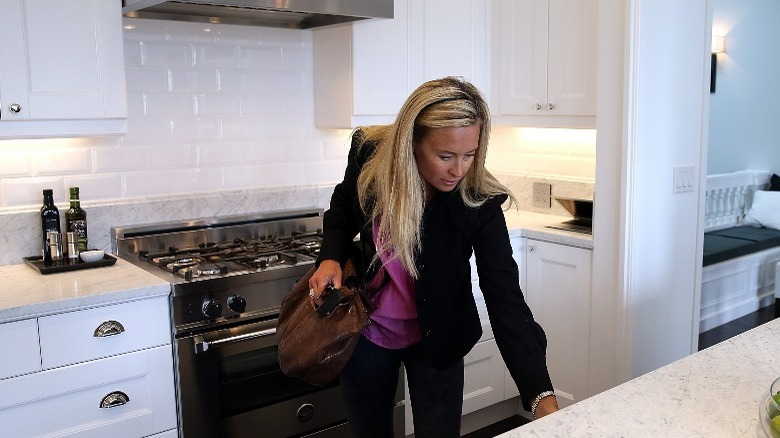The Unexpected Impact HGTV Has Had
Country Living may have explained HGTV's success best when they compared it to the famous Lay's potato chip tagline — you can't have just one. In this case, they emphasize how viewers tend to binge several HGTV shows or episodes at once. On reality TV, every renovation ends on time and looks amazing, which is definitely better than how things tend to go in real life. Plus, viewers can justify all the screen time because they feel like they're educating themselves, according to Market Watch. HGTV's success is partly due to its ability to adapt. There are shows for every generation and every interest, from DIY to home design. It's kept up well with changes in the real estate market and offers programs that demonstrate how you can renovate what you already own if buying a new house isn't possible.
HGTV's global impact goes far beyond binge-watching reality TV. An estimated $465 billion will be spent in the home-improvement industry in 2022, explains Vanity Fair, and the impact on the home-improvement industry can already be seen in the meteoric rise of net sales reported by stores like Lowes and Home Depot. When HGTV was launched in 1994, Lowes had just $6.1 million in net sales, according to Lowe's annual report that year. As of 2021, their net sales were reported at over $96 billion (via Lowes) and $151.2 billion (via Home Depot). The rise of retailers selling home furnishings, housewares, decor and remodeling products also exploded to meet the demand of consumers per Business Home.
HGTV hosts are relatable
HGTV programs have turned unknown contractors, interior designers, and real estate agents into celebrity-status stars and influencers. Unlike other reality TV shows, the hosts of most HGTV shows are very relatable, says Country Living. Whether it's "Fixer Upper," "Home Town," or "Love It or List It," people feel like they know the hosts. Isn't everyone on a first name basis with Joanna and Chip, and Erin and Ben?
Perhaps the biggest impact HGTV has had in its 28 years is how it has changed people's expectations for their homes and the way they talk about them, writes Architectural Digest. Homeownership has always been an American dream, but watching real people achieve their dream homes on television 24 hours a day, seven days a week has made it seem more tangible. Along with the internet, social media, and e-commerce, HGTV can be counted as a major driver of how prominently people's homes and furnishings figure in their lives.
How did HGTV get started?
It all started with media visionary, Kenneth Lowe, and his innovative ideas for home improvement shows. At the time, Lowe was responsible for purchasing syndicated programming for Scripps Howard TV Group and was frustrated by some of the program choices and the increasing cost of paying for popular content. The only home-focused TV show at the time was PBS's popular show, "This Old House." Lowe had several program ideas based on his interests and experiences with building and renovating his own homes. His ingenuity came together with his understanding of the type of TV programming people wanted to watch, the changes happening in cable television, the emerging internet, and the housing market, according to The Cable Center.
In the early 1990s, a housing boom was happening just as Baby Boomers were reaching prime homeownership years. The internet was just becoming a global commercial network, and with the launch of Realtor.com in 1996, people had the ability to search property listings online for the first time. Lowe knew that viewers wanted predictable, well-defined programming, available 24/7. When HGTV launched, homeowner priorities and expectations were changed forever. HGTV was the fourth largest network behind Fox News, ESPN, and MSNBC in 2018, when Discovery acquired Scripps Network Interaction for $11.9 billion.
The HGTV effect
The overall impact of home improvement shows has been a positive one. They help people to see more potential in their homes, offer lots of ideas, and may encourage buyers to consider a home that needs work, per The Chicago Tribune. But, as with all reality TV, there is some distortion created by these shows, and it's been coined the "HGTV effect." Sometimes homeowners want extensive renovations for unrealistic prices based on what they see on the shows. In real life, labor and materials cost more, and time frames don't always go as smoothly as it seems on the screen. There's also an expectation among house-hunters who want the upgrades they see on TV but are disappointed that homes in their price range don't offer these features. DIYers may take on a project that is more than they can handle, which can result in costly mistakes. In real life, these ventures are challenging, but on TV, the process is tidied into a satisfying 30 minutes, always complete with a happy ending, per Country Living.
HGTV can offer great tips and ideas, and help you feel inspired. Whether you're buying a home or renovating one, it's a good idea to speak with professionals such as a real estate agent, interior designer, general contractor, or architect who can give you a more realistic expectation of cost, time frame, and feasibility, per Mitchell Wall Architect and Design.



